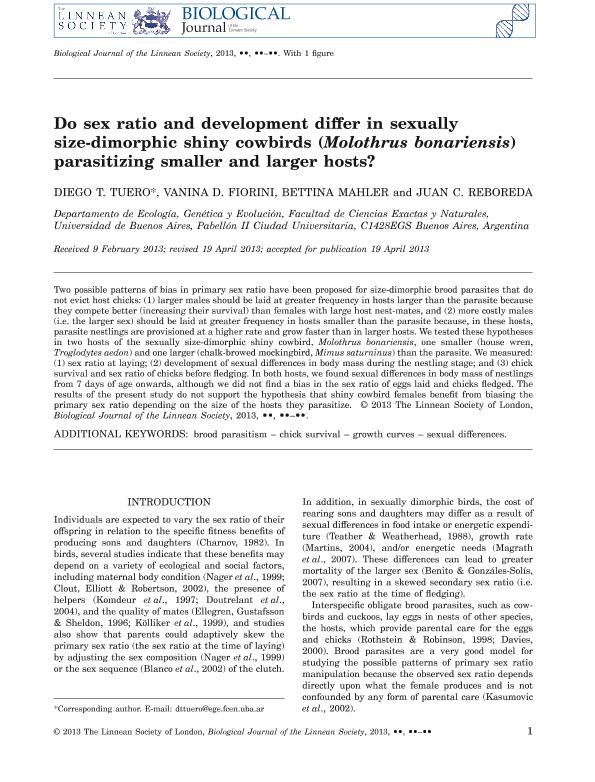Artículo
Do sex ratio and development differ in sexually size-dimorphic shiny cowbirds (Molothrus bonariensis) parasitizing smaller and larger hosts?
Fecha de publicación:
10/2013
Editorial:
Wiley
Revista:
Biological Journal Of The Linnean Society
ISSN:
0024-4066
Idioma:
Inglés
Tipo de recurso:
Artículo publicado
Clasificación temática:
Resumen
Two possible patterns of bias in primary sex ratio have been proposed for size-dimorphic brood parasites that do not evict host chicks: (1) larger males should be laid at greater frequency in hosts larger than the parasite because they compete better (increasing their survival) than females with large host nest-mates, and (2) more costly males (i.e. the larger sex) should be laid at greater frequency in hosts smaller than the parasite because, in these hosts, parasite nestlings are provisioned at a higher rate and grow faster than in larger hosts. We tested these hypotheses in two hosts of the sexually size-dimorphic shiny cowbird, Molothrus bonariensis, one smaller (house wren, Troglodytes aedon) and one larger (chalk-browed mockingbird, Mimus saturninus) than the parasite. We measured: (1) sex ratio at laying; (2) development of sexual differences in body mass during the nestling stage; and (3) chick survival and sex ratio of chicks before fledging. In both hosts, we found sexual differences in body mass of nestlings from 7 days of age onwards, although we did not find a bias in the sex ratio of eggs laid and chicks fledged. The results of the present study do not support the hypothesis that shiny cowbird females benefit from biasing the primary sex ratio depending on the size of the hosts they parasitize.
Palabras clave:
Molothrus Bonariensis
,
Growth Curves
,
Brood Parasitism
Archivos asociados
Licencia
Identificadores
Colecciones
Articulos(IEGEBA)
Articulos de INSTITUTO DE ECOLOGIA, GENETICA Y EVOLUCION DE BS. AS
Articulos de INSTITUTO DE ECOLOGIA, GENETICA Y EVOLUCION DE BS. AS
Citación
Tuero, Diego Tomas; Fiorini, Vanina Dafne; Mahler, Bettina; Reboreda, Juan Carlos; Do sex ratio and development differ in sexually size-dimorphic shiny cowbirds (Molothrus bonariensis) parasitizing smaller and larger hosts?; Wiley; Biological Journal Of The Linnean Society; 110; 2; 10-2013; 442-448
Compartir
Altmétricas




